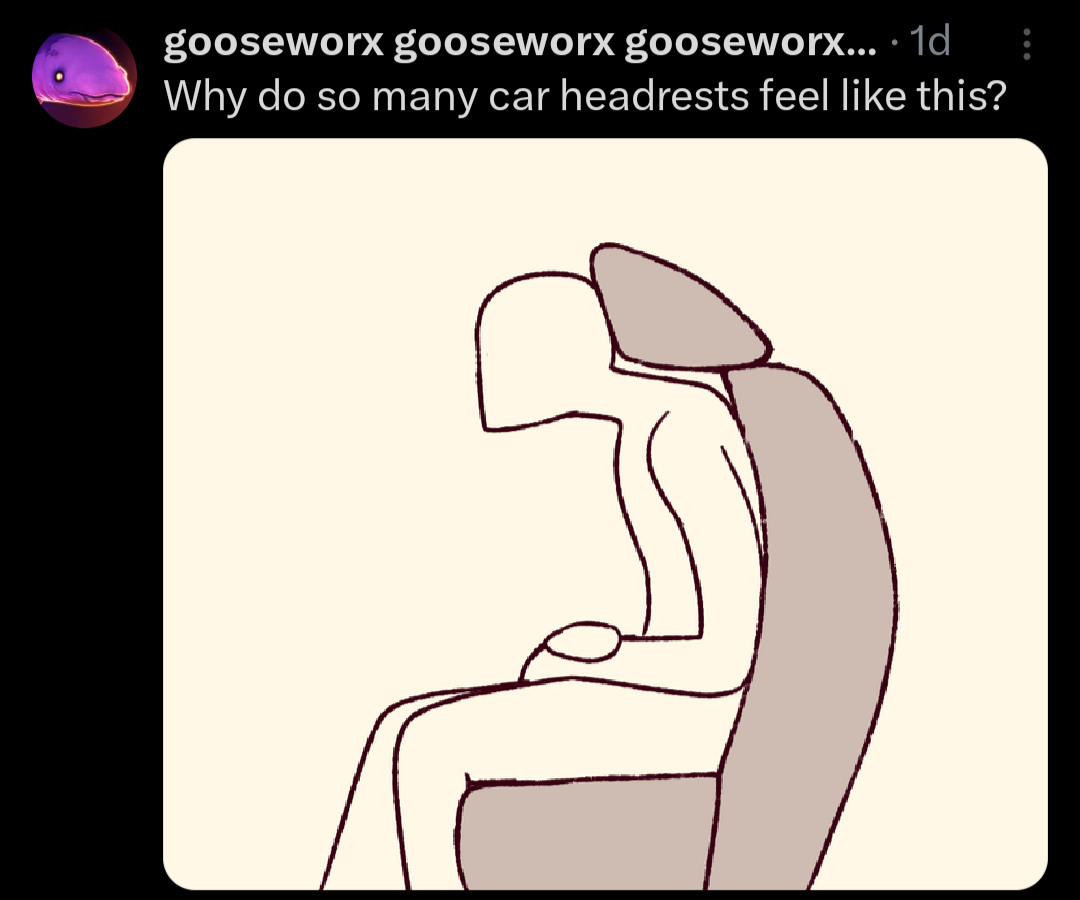this post was submitted on 29 Oct 2024
865 points (97.9% liked)
Microblog Memes
5699 readers
3311 users here now
A place to share screenshots of Microblog posts, whether from Mastodon, tumblr, ~~Twitter~~ X, KBin, Threads or elsewhere.
Created as an evolution of White People Twitter and other tweet-capture subreddits.
Rules:
- Please put at least one word relevant to the post in the post title.
- Be nice.
- No advertising, brand promotion or guerilla marketing.
- Posters are encouraged to link to the toot or tweet etc in the description of posts.
Related communities:
founded 1 year ago
MODERATORS
you are viewing a single comment's thread
view the rest of the comments
view the rest of the comments

Does anyone else have the opposite problem? I feel like head rests are always too far back. If I place my head flat against them then more often than not I'm in an uncomfortable driving position because my neck is tilted back and up. I have to lean forward to drive most cars and it really annoys me.
Edit: I'm starting to think that a lot of you drive with the seat in an upright position. I sit at a slight recline because it's easier on my back. Maybe that's the problem. Try reclining more.
Yes you need to tilt your seat up. I'm a fatass and do it. So can you.
But sitting up straight is bad for posture. It compresses your back, which makes the pain worse.
What kind of crack is that? Nobody has ever been told to lean back in a chair. I have however been told to sit up straight.
We all have by our parents, and they were wrong. A 45° angle is ideal because your spine isn't being compressesed by gravity as much. Just think about it. It doesn't take a genius to figure out simple physics.
FWIW, I did have a source, but unfortunately I can't find it at the moment.
I had a driving safety instructor tell me that's on purpose, and they are not comfort, but safety devices, and you should not drive while leaning against it.
The seat should support your full back, but the headrest should be a few centimetres behind your head so you can still look around, but it can lessen the effects of whiplash.
No. That's crazy talk.
Older cars were like that, but more recently usually have headsets that can adjust forward and back
Define "older". I've never owned a car newer than 10 years old, and plenty of 10-15 year old cars have this problem.
My old car (2007) had adjustable head rests, my current car (2019) does not. Fortunately its not too bad but I would height adjust it an inch or two higher if I could (just like when I get on an airplane). Weirdly, I was battling a really sore neck for a few months and a couple of road trips (1500 miles each way), actually was pretty comfortable. I didn't have to lay down for a couple of hours in the middle of the day.
That still might fit, or maybe the feature is not as common as I thought. Certainly it varies by manufacturer , with some being more laggard than others.
My last car I remember not being adjustable was a 1996 Pontiac. It did adjust up-down and was high enough to improve safety rather than risk, but it was too far back and did not adjust front-back so my head would rattle around a lot if there were an accident. I’m pretty sure the Honda, Toyota, and Subaru I had since then all had adjustable headrests. Admittedly I do remember being bothered by something so close until I got used to it, but I knew it was a safety improvement and the front-back adjustment generally allowed me to get it out of the way while minimizing head travel if an accident
As a taller guy, this is something I especially notice: most of my driving life a headrest would simply break my neck if there were an accident. Having it be high enough to act as a safety feature rather than increase risk, was a huge advance, and the more recent adjustment front-back works much better
Yet somehow my Tesla fits best of all despite not adjusting at all: neither up-down nor front-back.
Perhaps you live in a place with different vehicle safety requirements. In the US, uncomfortable forward-tilted headrests are mandated by the federal government.
I'm in the US.